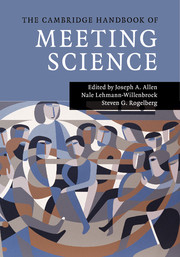Book contents
- The Cambridge Handbook of Meeting Science
- The Cambridge Handbook of Meeting Science
- Copyright page
- Dedication
- Contents
- Tables
- Figures
- Contributors
- Book part
- Part I Introduction
- Part II Premeeting Activities and Context
- Meeting Setup
- Meeting Composition
- 6 How Differences Make a Difference
- 7 Meetings across Cultures
- Premeeting Communication
- Macro Meeting Context
- Part III The Meeting Itself
- Part IV Special Types of Meetings
- Part V Synthesis and Conclusion
- Book part
- Author Index
- Subject Index
- References
6 - How Differences Make a Difference
The Role of Team Diversity in Meeting Processes and Outcomes
from Meeting Composition
Published online by Cambridge University Press: 05 August 2015
- The Cambridge Handbook of Meeting Science
- The Cambridge Handbook of Meeting Science
- Copyright page
- Dedication
- Contents
- Tables
- Figures
- Contributors
- Book part
- Part I Introduction
- Part II Premeeting Activities and Context
- Meeting Setup
- Meeting Composition
- 6 How Differences Make a Difference
- 7 Meetings across Cultures
- Premeeting Communication
- Macro Meeting Context
- Part III The Meeting Itself
- Part IV Special Types of Meetings
- Part V Synthesis and Conclusion
- Book part
- Author Index
- Subject Index
- References
Summary
In this chapter, we explore the role of team diversity as an input factor for organizational meeting processes and outcomes. Team diversity refers to aggregated differences among group members that can be either relations oriented (social category diversity; e.g., age, gender, race) or task oriented (functional diversity; e.g., education, functional background, tenure). We posit that these two diversity dimensions may have either positive or negative effects on meeting effectiveness contingent on various contextual conditions. Specifically, we argue that interaction processes taking place in team meetings constitute the mediating link between diversity as an input factor and meeting outcomes. Based on this assumption, we develop a model linking both types of diversity to functional versus dysfunctional interactions in meetings. We use this model to derive a number of propositions regarding the links between diversity as an input factor, interaction processes during meetings as mediating mechanisms, and meeting outcomes. By connecting the dots between team diversity and meeting dynamics, we aim to deepen our understanding of the role of participants' diversity in meetings and inspire future research testing the suggested propositions.
- Type
- Chapter
- Information
- The Cambridge Handbook of Meeting Science , pp. 93 - 118Publisher: Cambridge University PressPrint publication year: 2015
References
- 6
- Cited by

